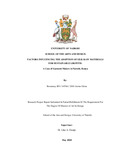| dc.description.abstract | Garment making Enterprises in Kenya have been affected drastically by continuous
closure of textiles industries (from 52 Mills in 1984 to 15 main textiles mills),
rendering the sector to import expensive synthetics and other natural raw materials.
This is as a result of inadequate textile raw materials due to climate changes caused
by global warming. The objective of the study was to investigate the effect of
adoption of underutilized silk materials by garment makers, in Nairobi, Kenya and
perceived economic benefits on the adoption of silk raw materials in relation to social
cultural attitudes on the adoption of silk raw materials. The study population
comprised of all the Garment shop owners in the Central Business District of Nairobi
and its environs. Purposive, snowballing techniques were applied to deduce the
sample. The sample of the study was 54 Garment shop owners in the CBD and its
environs. Consumers and two case studies were conducted at Gramwa Hand-crafts
and Kiko Romeo, using collective method of case study. Primary data was collected
through the administration of the questionnaires, which were first checked for
completeness. Data gathered from correctly filled questionnaires was coded, tabulated
and analyzed using Statistical Package for Social Sciences(SPSS) by both descriptive
statistics which included mean and standard deviation to capture the characteristics of
the variables under study and inferential statistics which included regression
coefficient which was used to analyze the relationship of the dependent and the
independent variables. Editing and coding was used to give a clear picture of the
targeted objectives while frequency distribution enabled the researcher to
meaningfully describe the distribution of measurements used as graphs and charts.
This analysis enabled the researcher to establish the effect of adoption of silk
materials by garment makers, in Nairobi, Kenya. Based on the findings above the
study concluded that cost of silk, skills and competence perceived economic benefits,
social cultural attitudes and technology, greatly influenced the adoption of silk
material by small scale garment makers. The study recommended that Silk reeling
units should be established in the counties which have sericulture farms and at least
one weavers training centers should be opened having free training and lodging
facilities. Also there was needed sensitization and awareness programs to inform the
garment makers and end users of the uses, economic benefits and maintenance of silk
products and raw materials. | en_US |



